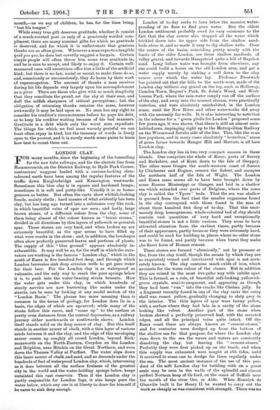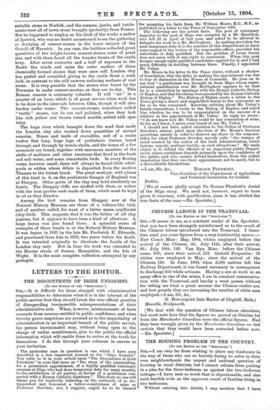LONDON CLAY.
FOR many months, since the beginning of the tunnelling for the new tube railways, and for the electric line from Hammersmith, on the District Railway, to Hyde Park Corner, contractors' waggons loaded with a curious-looking slate- coloured earth have been among the regular features of the traffic down Knightsbridge and Kensington westwards. Sometimes this blue clay is in square and hardened lumps ; sometimes it is soft and putty-like. Usually it is as homo- geneous as butter. But often the carts show whitish-looking fossils, mainly shells ; hard masses of what evidently has been clay, but has long ago turned into a substance very like rock, in which beautiful veins of spar are seen ; and lastly, large brown stones, of a different colour from the clay, some of them being almost of the colour known as "burnt sienna," divided in all directions by thin layers of yellowish or greenish spar. These stones are very hard, and when broken up are extremely beautiful, as the spar seems to have filled up what were cracks in the stone ; and, in addition, the breakages often show perfectly preserved leaves and portions of plants. The supply of this "blue ground" appears absolutely in- exhaustible. It may well be so, for the stuff in which the exca- vators are working is the famous "London clay," which in the south of Essex is five hundred feet deep, and through which London breweries sink deep artesian wells to get pure water for their beer. For the London clay is as waterproof as vulcanite, and the only way to reach the pure springs below it is to push into the water-bearing strata beneath. How the water gets under this clay, in which hundreds of sturdy navvies are now burrowing like moles under the streets, can be seen by looking at any model section of the "London Basin." The phrase has more meaning than is common in the terms of geology, for London does lie in a basin, the edges of which are upcurved; while many of the strata follow this curve, and "come up" to the surface at pretty even distances from the central depression, as a railway journey either northwards or southwards shows. London itself stands solid on its deep saucer of clay. But this itself stands in another saucer of chalk, with a thin layer of various sands between it and the clay, and the edge of this enveloping saucer comes up roughly all round London, beyond Rick- mansworth on the North-Eastern, Croydon on the London and Brighton, near Hitchin on the Great Northern, and even down the Thames Valley at Purfleet. The water slips down this inner saucer of chalk and sand, and so descends under the hundreds of feet of waterproof London clay, which, intervening as it does between all the surface foulness of the greatest city in the world and the water-holding sponge below, keeps untainted this vast reservoir. Thus if the London clay is partly responsible for London fogs, it also keeps pure the water below, which any one is at liberty to draw for himself if he coxes to sink deep enough. London of to-day seeks to bore below the massive water- proofing of its floor to find pure water. But the oldest London settlement probably owed its very existence to the fact that the clay saucer also stopped all the water which trickled down into its upper side from the shallow sand- beds above it, and so made it easy to dig shallow wells. Over the centre of the basin, coinciding pretty nearly with the limits of the older London, are these shallow sandbeds, of valley gravel, and towards Hampstead quite a bill of Bagshot sand. Long before water was brought from elsewhere, any one could build a house on the old London area, and get a water supply merely by sinking a well down to the clay saucer over which the water lay. Professor Prestwich has pointed out that the hills to the north-west, made of the London clay without any gravel on the top, such as Holloway, Camden Town, Regent's Park, St. John's Wood, and West- bourne Park, where the rain-water simply ran off the surface of the clay, and away into the nearest stream, were practically waterless, and were absolutely uninhabited, in the London sense, until the New River and other waterworks did away with the necessity for wells. It is also interesting to note that in the scheme for a "green girdle for London" proposed some few years ago, it was shown that there is still an almost unin- habited area, impinging right up to the Metropolitan Railway on the Wormwood Scrubs side of the line. This, like the even less populous, and in many cases absolutely "homeless," areas of grass farms towards Hanger Hill and Harrow, is all bare London clay.
The London clay lies in two very compact masses in these islands. One comprises the whole of Essex, parts of Surrey and Berkshire, and of Kent down to the Isle of Sheppey. The other mass fringes the south-western coast of Sussex by Chichester and Bognor, crosses the Solent, and occupies the northern half of the Isle of Wight. The London and Essex mass seems all to have been brought down by some Eocene Mississippi or Ganges, and laid in a shallow sea which extended over parts of Belgium, where the same clay is called the " Ypres " beds. That the sea was shallow is guessed from the fact that the smaller organisms found in the clay correspond with those found in the seas of about three hundred feet deep of to-day. That this enor- mously deep, homogeneous, whole-coloured bed of clay should contain vast quantities of very hard and exceptionally beautiful stones is not a little curious. They seem to have attracted attention from the earliest times, partly because of their appearance, partly becau se they were extremely bard, and could be used for building in places where no other stone was to be found, and partly because when burnt they make the finest form of Roman cement.
These stones are formed "chemically," not by pressure or fire, from the clay itself, though the means by which they are so exquisitely veined and interleaved with spar is not accu- rately known. The clay contains much oxide of iron, which accounts for the warm colour of the stones. But in addition they are veined in the most irre gular way with calcite spar. This is formed, as a rule, of beautiful soft-looking yellowish- green crystals, semi-transparent, and appearing as though they had been " run " into the cracks like Chelsea jelly. In a fragment recently found in one of the clay carts the outer shell was russet yellow, gradually changing to slaty grey in the interior. The thin layers of spar were tawny yellow, with a surface where they had lain in a cavity of the stone looking like velvet. Another part of the stone when broken showed a perfectly preserved lea!, with the serrated edges, and all the principal veins quite intact. Off the Essex coast these are always known as "cement-stones." and for centuries were dredged up from the bottom of the shallow sea for that purpose, for where the London clay runs down to the sea the waves and waters are constantly dissolving the clay, but leaving the "cement-stones." Probably they were first picked up on the beach, and when this supply was exhausted were sought at ebb tides, until it occurred to some one to dredge for them regularly under the sea. The most ancient instance of the use of this pro- duct of the soft London clay for building with dn a great scale may be seen in the walls of the splendid and almost perfect Norman keep of Or ford, on the coast of Suffolk near the mouth of the river Ore, or Aide. When Ranulph de Glanville built it for Henry II. he wanted to carry out the work as cheaply as was consistent with strength. There was no suitable stone in Norfolk, and the corners, jambs, and battle- ments were all of hewn stone brought (probably) from France. But be happened to employ as his clerk of the works a native of Ipswich, who was no doubt accustomed to see the gathering or dredging of cement-stones in the lower estuary of the Orwell off Harwich. In any case, the builders collected great quantities of the bright-brown cement-stones, some of great size, and with them faced all the broader fronts of the castle keep. After seven centuries and a half of exposure to the North Sea winds and rains the outer surface of these chemically formed atones that were once soft London clay has peeled and crumbled, giving to the castle front a sunk look, in contrast to the still unworn enduring surfaces of real stone. It is very possible that the stones were burnt by the Normans to make cement-mortar, as they are to-day. This Roman cement is extremely valuable. It will "set" in a quarter of an hour, which is of great service when work has to be done in the intervals between tides, though it will also harden -under water. The cement-stones, sometimes called " turtle " stones, can be cut and polished, when they look like rich yellow and brown veined marble, netted with spar inlay.
The huge river which brought down the mud that made the London clay also washed down quantities of animal remains. Bones and teeth of crocodiles, and of a snake twelve feet long, huge logs of prehistoric timber, bored through and through by teredo-shells, and the bones of a few mammals are found, together with enormous numbers of the shells of molluscs and other creatures that lived in the fresh and salt water, and some remarkable birds. In every flowing water, however small, there will always be found little whirl- pools or eddies where debris is deposited, from the modern Thames to the tiniest brook. The great mud-pie, with plums of this kind in it, on the prehistoric Ganges of England was at Sheppey. Other parts of the clay may hold absolutely no fossils. The Sheppey cliffs are stuffed with them, or rather with the iron pyrites casts made of them, which must be kept in oil or they dissolve.
Among the bird remains from Sheppey now at the Natural History Museum are those of a vulture-like bird, and of another called, for want of a better name, argillornis (clay-bird). This suggests that it was the father of all clay pigeons, but it appears to have been a kind of albatross. A large heron was also found there. A splendid series of examples of these fossils is at the Natural History Museum. It was begun in 1835 by the late Mr. Frederick E. Edwards, and purchased from him in 1873, two years before his death. It was intended originally to illustrate the fossils of the London clay only. But in time his work was extended to the Eocene strata of Sussex, Hampshire, and the Isle of Wight. It is the most complete collection attempted by any geologist.











































 Previous page
Previous page